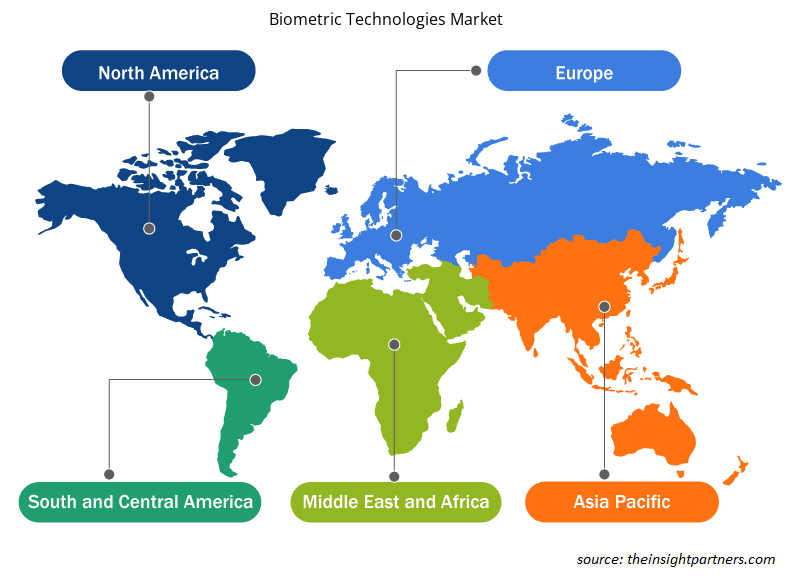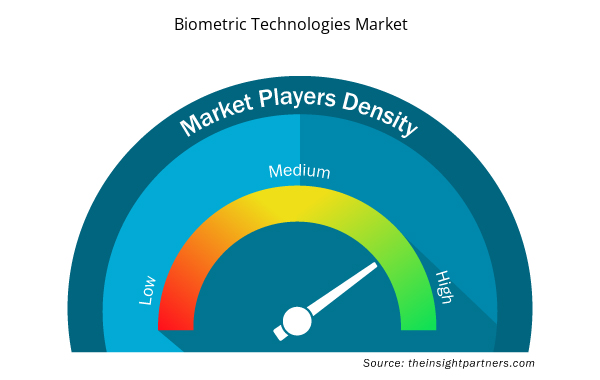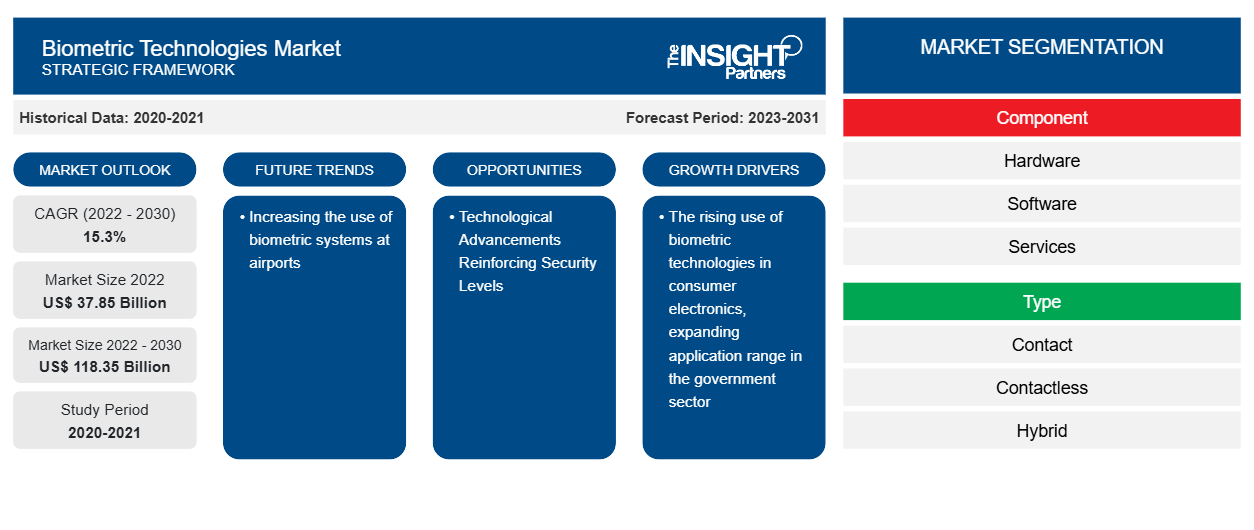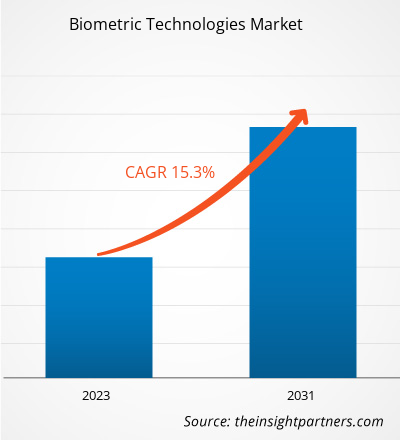生物识别技术市场规模预计将从 2022 年的 378.5 亿美元增至 2030 年的 1183.5 亿美元。预计 2022-2030 年期间,该市场的复合年增长率将达到 15.3%。机场越来越多地使用生物识别系统可能仍是市场的一个主要趋势。
生物识别技术市场分析
生物识别技术涉及对个人独特的身体和行为特征进行评估和统计分析。该技术主要用于身份识别和访问控制;尽管如此,它也用于验证受观察个人的身份。生物识别认证的目的是根据个人的内在身体或行为特征可靠地识别他们。生物识别技术市场报告强调了推动市场发展的关键因素和突出的公司发展。
生物识别技术市场概览
生物识别系统识别和分析的特定身体和行为特征包括虹膜或视网膜模式、语音模式、指纹、面部特征以及步态或打字节奏等行为特征。指纹扫描仪是全球最常用的生物识别认证方式之一;它们可以捕捉个人指尖上独特的山谷或脊线图案。生物识别技术在日常安全任务中变得越来越重要。这些个人独特的身份识别特征被用作手机、电脑和笔记本电脑的密码;此外,它们还用于控制房间和建筑物的访问。一旦扫描了这些生物特征数据,就会将其存储起来,以便将来执行类似的操作。通常,生物特征数据存储和加密在设备或远程服务器中。生物识别技术最常用于众多行业的身份验证、识别和访问控制目的。医疗保健、安全、银行、金融服务和保险 (BFSI) 等行业对生物识别技术的需求飙升,为整个生物识别技术市场的增长做出了重大贡献。
全球人口增长和快速城市化推动了消费电子和 IT 行业的发展。消费电子行业的扩张,加上对智能手机、平板电脑、笔记本电脑、智能手表和门禁系统的需求不断增长,极大地促进了生物识别技术市场规模的扩大。消费者非常关心维护其数据和个人信息的隐私,这反映了对集成在智能手机、平板电脑、笔记本电脑、智能手表和其他消费电子设备中的生物识别认证功能的需求很高。指纹扫描仪高度集成到智能手机和平板电脑中,为消费者提供额外的安全保障。生物识别技术在消费电子产品中的应用日益广泛,这是促进生物识别技术市场增长的一个关键因素。
定制此报告以满足您的需求
您可以免费定制任何报告,包括本报告的部分内容、国家级分析、Excel 数据包,以及为初创企业和大学提供优惠和折扣
- 获取此报告的关键市场趋势。这个免费样品将包括数据分析,从市场趋势到估计和预测。
生物识别技术市场驱动因素和机遇
扩大政府领域应用范围 利好市场
不同国家的政府机构将生物识别技术用于各种验证目的,例如国家身份证系统、边境管制基础设施或福利计划验证。生物识别技术在政府运作中的采用通常会为数据格式和系统设定标准,从而导致工业部门更广泛地采用生物识别技术,并为制造商带来规模经济。生物识别技术正在多个政府项目中部署。2023 年 12 月,公民和移民服务局与 Amentum (弗吉尼亚州) 签署了一份价值 2.825 亿美元的合同,安装生物识别系统,以帮助在 130 个 CIS 申请支持中心 (ASC) 地点处理合法移民申请。该机构于 2023 年 9 月与 Amentum 签订了一份为期五年、价值 4.07 亿美元的合同,以自动化收集申请在该国居住的人的生物特征和其他数据的过程。此外,2023 年 12 月,印度政府宣布,有资格签发 Aadhaar 卡的人可以在无法进行指纹扫描或无法进行指纹扫描的情况下使用虹膜扫描进行登记。政府和商业领域对生物识别技术的使用日益增多,促进了生物识别技术市场的发展。
技术进步增强安全水平
生物识别技术的技术进步主要集中在提高其多功能性、安全性和普及性。人工智能 (AI) 和机器学习 (ML) 进一步提高了生物识别系统的准确性和可靠性,降低了误报和漏报的可能性,这将对安全性和用户信心产生积极影响。人工智能驱动的生物识别技术的扩展,特别是面部和行为生物识别技术(步态、语音和口音识别),可能会推动通过本地摄像头进行实时生物识别身份验证的新形式的出现。随着人工智能的最新进步,生物识别身份验证技术在工业领域变得越来越普遍。据 IBM 称,20% 的违规行为是由于凭证被盗造成的。
此外,检测和解决数据泄露平均需要 287 天,这进一步加剧了影响。基于人工智能的安全解决方案很可能有助于企业在任何领域保持竞争力。IBM 提到,截至 2021 年,25% 的公司已全面实施基于人工智能的安全措施,而 40% 的公司已完成部分实施。
生物识别技术市场报告细分分析
有助于生物识别技术市场分析的关键部分是组件、类型、身份验证类型和最终用户。
- 根据组件,生物识别技术市场分为硬件、软件和服务。硬件部分在 2022 年占据最大份额。
- 根据类型,市场分为接触式、非接触式和混合式。
- 根据身份验证类型,市场分为单因素身份验证和多因素身份验证。
- 根据最终用户,市场分为政府、BFSI、医疗保健、国防和安全等。
生物识别技术市场份额(按地区)分析
生物识别技术市场报告的地理范围主要分为五个地区:北美、亚太、欧洲、中东和非洲、南美和中美。
2022 年,北美占据了生物识别技术市场份额的主导地位。该地区的市场分为美国、加拿大和墨西哥。北美市场经历了强劲而稳定的增长。强劲的经济和政府的支持导致美国多个行业广泛采用高科技产品、硬件、软件和其他组件。由于 IT 行业对生物识别解决方案的需求激增以及网络钓鱼攻击的数量不断增加,预计北美市场在预测期内将以显着的速度增长。这鼓励市场参与者开发先进的软件来保护他们的客户免受凭证盗窃。例如,2023 年 11 月,Accu-Time Systems, Inc. 宣布推出 Only|You Face 面部识别系统,以提供安全、可靠和非接触式计时工作流程。Only|You Face 提供了比指纹读取器或键盘更卫生的替代方案。在加拿大,政府正在采用生物识别技术来加强国家安全措施。与使用生物识别技术相关的严格政府规则和法规正在推动市场的发展。例如,2024 年 1 月,加拿大隐私专员 (OPC) 起草了有关将生物识别技术用于适当目的的指南。这些指南避免了导致违反人权法的不公平、不道德或歧视性待遇的分析或分类。
生物识别技术市场区域洞察
Insight Partners 的分析师已详细解释了预测期内影响生物识别技术市场的区域趋势和因素。本节还讨论了北美、欧洲、亚太地区、中东和非洲以及南美和中美洲的生物识别技术市场细分和地理位置。

- 获取生物识别技术市场的区域特定数据
生物识别技术市场报告范围
| 报告属性 | 细节 |
|---|---|
| 2022 年市场规模 | 378.5亿美元 |
| 2030 年的市场规模 | 1183.5亿美元 |
| 全球复合年增长率(2022 - 2030 年) | 15.3% |
| 史料 | 2020-2021 |
| 预测期 | 2023-2031 |
| 涵盖的领域 | 按组件
|
| 覆盖地区和国家 | 北美
|
| 市场领导者和主要公司简介 |
|
生物识别技术市场参与者密度:了解其对业务动态的影响
生物识别技术市场正在快速增长,这得益于终端用户需求的不断增长,而这些需求又源于消费者偏好的不断变化、技术进步以及对产品优势的认识不断提高等因素。随着需求的增加,企业正在扩大其产品范围,进行创新以满足消费者的需求,并利用新兴趋势,从而进一步推动市场增长。
市场参与者密度是指在特定市场或行业内运营的企业或公司的分布情况。它表明在给定市场空间中,相对于其规模或总市场价值,有多少竞争对手(市场参与者)存在。
在生物识别技术市场运营的主要公司有:
- 意识公司
- 泰雷兹公司
- 认知系统有限公司
- 日本电气公司
- 法国 IDEMIA SAS
- HID全球公司
免责声明:上面列出的公司没有按照任何特定顺序排列。

- 获取生物识别技术市场顶级关键参与者概览
生物识别技术市场新闻和最新发展
生物识别技术市场通过收集一手和二手研究后的定性和定量数据进行评估,其中包括重要的公司出版物、协会数据和数据库。以下列出了生物识别技术市场的一些发展情况:
- NEC 和万事达卡合作在店内生物识别支付方面取得进展。此次合作通过签署谅解备忘录,实施了 NEC 的面部识别和活体验证技术、万事达卡的支付支持以及增强的用户体验,以推动全球可扩展性。(来源:NEC 公司,新闻稿,2023 年 11 月)
- IDEMIA 与印度联邦银行有限公司合作,通过非接触式生物识别门禁系统增强其现有的门禁和人员管理系统。该解决方案基于 IDEMIA 的 SmartBio SDK 构建,使用面部和虹膜验证来验证人员的出勤情况和对核心银行系统的访问权限。(来源:IDEMIA,新闻稿,2021 年 2 月)
生物识别技术市场报告覆盖范围和交付成果
“生物识别技术市场规模和预测(2020-2030 年)”报告对以下领域进行了详细的市场分析:
- 生物识别技术市场规模及全球、区域和国家层面所有主要细分市场的预测
- 生物识别技术市场趋势,以及驱动因素、限制因素和关键机遇等市场动态
- 详细的 PEST/波特五力分析和 SWOT 分析
- 生物识别技术市场分析涵盖主要市场趋势、全球和区域框架、主要参与者、法规和最新市场发展
- 行业格局和竞争分析,涵盖市场集中度、热图分析、知名参与者以及生物识别技术市场的最新发展
- 详细的公司简介
- 历史分析(2 年)、基准年、预测(7 年)及复合年增长率
- PEST 和 SWOT 分析
- 市场规模价值/数量 - 全球、区域、国家
- 行业和竞争格局
- Excel 数据集


- Wind Turbine Composites Market
- Digital Language Learning Market
- Flexible Garden Hoses Market
- Small Molecule Drug Discovery Market
- Nuclear Decommissioning Services Market
- Railway Braking System Market
- Electronic Shelf Label Market
- Wheat Protein Market
- Queue Management System Market
- Retinal Imaging Devices Market

Report Coverage
Revenue forecast, Company Analysis, Industry landscape, Growth factors, and Trends

Segment Covered
This text is related
to segments covered.

Regional Scope
North America, Europe, Asia Pacific, Middle East & Africa, South & Central America

Country Scope
This text is related
to country scope.
常见问题
The biometric technologies market is expected to register a CAGR of 15.3% during 2022–2030
The biometric technologies market size is projected to reach US$ 118.35 billion by 2030
North America dominated the biometric technologies market in 2022.
The rising use of biometric technologies in consumer electronics and expanding application range in the government sector are expected to drive the biometric technologies market.
Increasing the use of biometric systems at airports is likely to remain a key trend in the market.
Aware Inc, Thales SA, Cognitec Systems GmbH, NEC Corp, IDEMIA France SAS, HID Global Corp, Fujitsu Ltd, Leidos Holdings Inc, M2SYS Technology, and Precise Biometrics AB are among the leading payers operating in the biometric technologies market.
Trends and growth analysis reports related to Electronics and Semiconductor : READ MORE..
The List of Companies – Biometric Technologies Market
- Aware Inc
- Thales SA
- Cognitec Systems GmbH
- NEC Corp
- IDEMIA France SAS
- HID Global Corp
- Fujitsu Ltd
- Leidos Holdings Inc
- M2SYS Technology
- Precise Biometrics AB
The Insight Partners performs research in 4 major stages: Data Collection & Secondary Research, Primary Research, Data Analysis and Data Triangulation & Final Review.
- Data Collection and Secondary Research:
As a market research and consulting firm operating from a decade, we have published and advised several client across the globe. First step for any study will start with an assessment of currently available data and insights from existing reports. Further, historical and current market information is collected from Investor Presentations, Annual Reports, SEC Filings, etc., and other information related to company’s performance and market positioning are gathered from Paid Databases (Factiva, Hoovers, and Reuters) and various other publications available in public domain.
Several associations trade associates, technical forums, institutes, societies and organization are accessed to gain technical as well as market related insights through their publications such as research papers, blogs and press releases related to the studies are referred to get cues about the market. Further, white papers, journals, magazines, and other news articles published in last 3 years are scrutinized and analyzed to understand the current market trends.
- Primary Research:
The primarily interview analysis comprise of data obtained from industry participants interview and answers to survey questions gathered by in-house primary team.
For primary research, interviews are conducted with industry experts/CEOs/Marketing Managers/VPs/Subject Matter Experts from both demand and supply side to get a 360-degree view of the market. The primary team conducts several interviews based on the complexity of the markets to understand the various market trends and dynamics which makes research more credible and precise.
A typical research interview fulfils the following functions:
- Provides first-hand information on the market size, market trends, growth trends, competitive landscape, and outlook
- Validates and strengthens in-house secondary research findings
- Develops the analysis team’s expertise and market understanding
Primary research involves email interactions and telephone interviews for each market, category, segment, and sub-segment across geographies. The participants who typically take part in such a process include, but are not limited to:
- Industry participants: VPs, business development managers, market intelligence managers and national sales managers
- Outside experts: Valuation experts, research analysts and key opinion leaders specializing in the electronics and semiconductor industry.
Below is the breakup of our primary respondents by company, designation, and region:

Once we receive the confirmation from primary research sources or primary respondents, we finalize the base year market estimation and forecast the data as per the macroeconomic and microeconomic factors assessed during data collection.
- Data Analysis:
Once data is validated through both secondary as well as primary respondents, we finalize the market estimations by hypothesis formulation and factor analysis at regional and country level.
- Macro-Economic Factor Analysis:
We analyse macroeconomic indicators such the gross domestic product (GDP), increase in the demand for goods and services across industries, technological advancement, regional economic growth, governmental policies, the influence of COVID-19, PEST analysis, and other aspects. This analysis aids in setting benchmarks for various nations/regions and approximating market splits. Additionally, the general trend of the aforementioned components aid in determining the market's development possibilities.
- Country Level Data:
Various factors that are especially aligned to the country are taken into account to determine the market size for a certain area and country, including the presence of vendors, such as headquarters and offices, the country's GDP, demand patterns, and industry growth. To comprehend the market dynamics for the nation, a number of growth variables, inhibitors, application areas, and current market trends are researched. The aforementioned elements aid in determining the country's overall market's growth potential.
- Company Profile:
The “Table of Contents” is formulated by listing and analyzing more than 25 - 30 companies operating in the market ecosystem across geographies. However, we profile only 10 companies as a standard practice in our syndicate reports. These 10 companies comprise leading, emerging, and regional players. Nonetheless, our analysis is not restricted to the 10 listed companies, we also analyze other companies present in the market to develop a holistic view and understand the prevailing trends. The “Company Profiles” section in the report covers key facts, business description, products & services, financial information, SWOT analysis, and key developments. The financial information presented is extracted from the annual reports and official documents of the publicly listed companies. Upon collecting the information for the sections of respective companies, we verify them via various primary sources and then compile the data in respective company profiles. The company level information helps us in deriving the base number as well as in forecasting the market size.
- Developing Base Number:
Aggregation of sales statistics (2020-2022) and macro-economic factor, and other secondary and primary research insights are utilized to arrive at base number and related market shares for 2022. The data gaps are identified in this step and relevant market data is analyzed, collected from paid primary interviews or databases. On finalizing the base year market size, forecasts are developed on the basis of macro-economic, industry and market growth factors and company level analysis.
- Data Triangulation and Final Review:
The market findings and base year market size calculations are validated from supply as well as demand side. Demand side validations are based on macro-economic factor analysis and benchmarks for respective regions and countries. In case of supply side validations, revenues of major companies are estimated (in case not available) based on industry benchmark, approximate number of employees, product portfolio, and primary interviews revenues are gathered. Further revenue from target product/service segment is assessed to avoid overshooting of market statistics. In case of heavy deviations between supply and demand side values, all thes steps are repeated to achieve synchronization.
We follow an iterative model, wherein we share our research findings with Subject Matter Experts (SME’s) and Key Opinion Leaders (KOLs) until consensus view of the market is not formulated – this model negates any drastic deviation in the opinions of experts. Only validated and universally acceptable research findings are quoted in our reports.
We have important check points that we use to validate our research findings – which we call – data triangulation, where we validate the information, we generate from secondary sources with primary interviews and then we re-validate with our internal data bases and Subject matter experts. This comprehensive model enables us to deliver high quality, reliable data in shortest possible time.


 获取此报告的免费样本
获取此报告的免费样本